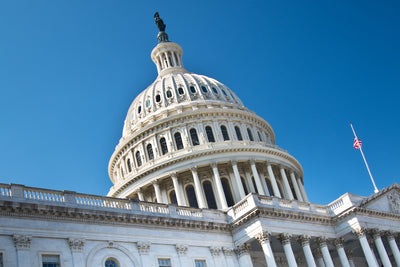Infrastructure Bill Update: How Are PFAS Addressed?
RSS
Analies Dyjak, M.A. & Emily Driehaus
Conversations around infrastructure have been the major political theme of 2021. The U.S. unfortunately has both outdated infrastructure and outdated laws when it comes to ensuring that Americans have access to safe drinking water. The recent proposals provided by the Biden Administration and Congress aim to update existing drinking water and wastewater regulations, but what about addressing newer unregulated contaminants? Over 200 million Americans drink water contaminated with a cancer-causing chemical called Per and Polyfluoroalkyl Substances or PFAS. How do the new infrastructure bills plan to address PFAS?
The Drinking Water and Wastewater Infrastructure Act
The Senate recently passed a $35 billion infrastructure bill to address nationwide water and sanitation updates. The Drinking Water and Wastewater Infrastructure Act includes reauthorizations for existing legacy programs and important new grants for necessary infrastructure improvements. The Senate’s bill proposes a significantly smaller budget than the President’s $111 billion water infrastructure allocation under the American Jobs Plan. Key sections of the Senates’ bill include; additional assistance and subsidies to disadvantaged communities, $500 million for the Lead Reduction Grant program, funding for voluntary lead testing in schools, and resiliency grants for water systems susceptible to the impacts of climate change. Check out a full list of key provisions by clicking here.
How Do New Infrastructure Bills Propose to Address PFAS?
It’s impossible to talk about infrastructure without highlighting harmful PFAS chemicals and the communities across the country grappling with how to address them. The most significant discrepancy between President Biden’s infrastructure plan and the Senate’s iteration is the explicit mention of PFAS chemicals. The President’s plan explicits allocates “...$10 billion in funding to monitor and remediate PFAS in drinking water…” whereas the Senate’s version fails to mention PFAS once. State’s will be able to decide how they want to use federal funds, but the explicit mention reinforces how pressing of an issue PFAS contamination has become in the U.S.
PFAS Action Act of 2021
As more evidence shows the negative effects of PFAS on human health, a bipartisan bill introduced in the House of Representatives aims to tackle PFAS pollution in drinking water and air. Michigan Representatives Debbie Dingell and Fred Upton introduced the PFAS Action Act of 2021 in April after an earlier version of the bill passed the House in January 2020 but was blocked by Sen. Mitch McConnell in the Senate.
What’s In The Bill?
If passed by Congress and signed into law, the PFAS Action Act of 2021 would require the EPA to take regulatory action on PFAS contamination in drinking water. These actions include establishing a national drinking water standard for two of the most common PFAS chemicals, perfluorooctanoic acid (PFOA) and perfluorooctanesulfonic acid (PFOS). These chemicals would also be designated as hazardous substances.
PFOA and PFOS are two of the most prevalent PFAS chemicals, but there are still others that have contaminated drinking water and lead to health problems. The bill would require the EPA to determine whether to add other PFAS chemicals to the hazardous substances list within five years. PFOA and PFOS would also be added as air pollutants with more PFAS chemicals potentially added as determined by the EPA.
The bill would give the EPA the power to put limits on the amount of PFAS that can be released during industrial processes. Wastewater treatment facilities and other water utilities would also be given $200 million annually to treat water contaminated with PFAS.
Current Federal PFAS Regulations
Under the Biden administration, the EPA has launched new initiatives to research PFAS contamination in the environment to gain a better understanding of these contaminants. EPA Administrator Michael Regan announced an EPA Council on PFAS in April, which would work with local governments to protect citizens against PFAS contamination. The EPA has also issued a health advisory for PFOA and PFOS. These health advisories are meant to inform the public and governments about these PFAS chemicals and provide recommendations, but they are not actually enforceable.
Some states have enacted their own PFAS regulations due to the lack of current federal regulation. For example, Michigan adopted PFAS regulations last summer that are stricter than the EPA’s guidance set forth in health advisories. If passed, the PFAS Action Act of 2021 would establish the first federal regulations on PFAS in drinking water and the environment.
What’s Next For The PFAS Action Act of 2021?
The bill has been reported by the House Committee on Energy and Commerce and is set to be scheduled for a vote. The bill’s co-sponsors are optimistic about the vote in both houses of Congress, as both have a Democratic majority. The previous version of the bill was blocked by Mitch McConnell, who controlled the Republican-majority Senate. President Biden campaigned on the promise to enact federal PFAS regulations, so he will likely sign the bill into law if it is passed by both houses. However, regardless of the bill’s status, The National Law Review expects federal PFAS regulations to be enacted by the end of this year.
Our Take:
All drinking water infrastructure improvements must include funding to address PFAS chemicals in water. Period. An estimated 200 million Americans drink PFAS-contaminated water on a daily basis. With this comes an increased risk of cancer, an increased risk of miscarriage and other reproductive effects, and a long list of other negative health outcomes.
Other Articles We Think You Might Enjoy:Yale: PFAS Increase Risk of Miscarriage by 80-120%
Does Your Water Filter Remove PFAS?
PFAS: Everywhere We Look We Find It


